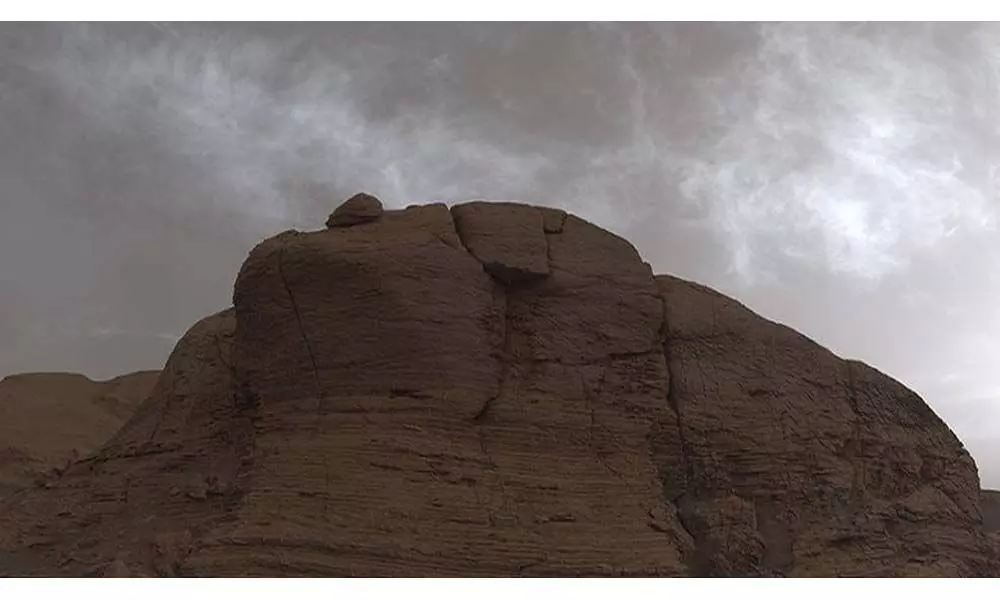Live
- ‘Game Changer’ team teases with a new promo
- Nara Lokesh emphasises overhaul of govt. schools and mid-day meal program
- Amid turmoil, air pollution peaks in Bangladesh as temperatures fall
- Google Trends unveils list of most searched ‘Indian Movies of 2024’
- BGT 2024-25: Hazlewood signals readiness for Brisbane Test after training with full run-up
- Google Presents Deep Research AI Tool for Comprehensive Web Reports
- Share of top 50 stocks to total market cap at all-time low: Report
- Nortje ruled out of SA’s remaining white-ball matches against Pakistan
- Mamata doesn't want INDIA bloc to succeed, claims BJP's Rahul Sinha
- Air India Express cancels flights at Chennai airport due to deluge
Just In
NASA's Mars Curiosity Rover snaps shining clouds on Red Planet


NASA's Mars Curiosity Rover snaps shining clouds on Red Planet
NASA's Mars Curiosity rover has captured shining clouds on the Red Planet, which arrived earlier and formed higher than expected.
Washington : NASA's Mars Curiosity rover has captured shining clouds on the Red Planet, which arrived earlier and formed higher than expected.
The atmosphere on Mars is usually thin, dry and cloudy days are rare. And clouds are typically found at the planet's equator in the coldest time of year, when Mars is the farthest from the Sun in its oval-shaped orbit. But the scientists noticed clouds forming over NASA's Curiosity rover earlier than expected, one full Martian year ago - two Earth years.
Inlate January, this year, the team started documenting these "early" clouds. The images show wispy puffs filled with ice crystals that scattered light from the setting Sun, some of them shimmering with colour.
The rover's Mast Camera, or Mastcam snapped colour images and the iridescent, or "mother of pearl" clouds on March 5, 2021, the 3,048th Martian day, or sol, of the mission.
"If you see a cloud with a shimmery pastel set of colors in it, that's because the cloud particles are all nearly identical in size. That's usually happening just after the clouds have formed and have all grown at the same rate," said Mark Lemmon, an atmospheric scientist with the Space Science Institute in Boulder, Colorado.
These clouds are among the more colorful things on the Red Planet, Lemmon added. If you were skygazing next to Curiosity, you could see the colours with the naked eye, although they'd be faint.
"I always marvel at the colours that show up: reds and greens and blues and purples. It's really cool to see something shining with lots of colour on Mars," Lemmon said.
On March 31, the 3,075th sol or Martian day of the mission, the navigation cameras on the mast of Curiosity also captured black-and-white images: fine, rippling structures of the clouds, just after sunset.
"Viewed just after sunset, their ice crystals catch the fading light, causing them to appear to glow against the darkening sky. These twilight clouds, also known as "noctilucent" (Latin for "night shining") clouds, grow brighter as they fill with crystals, then darken after the Sun's position in the sky drops below their altitude,a the US space agency said in a statement.
Beside being spectacular displays, such images help scientists understand how clouds form on Mars and why these recent ones are different, NASA said.
Further, the Curiosity team also discovered that the early-arrival clouds are actually at higher altitudes than is typical. Most Martian clouds hover no more than about 37 miles (60 kilometres) in the sky and are composed of water ice. But the clouds Curiosity has imaged are at a higher altitude, where it's very cold, indicating that they are likely made of frozen carbon dioxide, or dry ice.
Curiosity, which landed on Mars in 2012, was designed to assess whether Mars ever had an environment able to support small life forms called microbes. In other words, its mission is to determine the planet's "habitability".

© 2024 Hyderabad Media House Limited/The Hans India. All rights reserved. Powered by hocalwire.com






